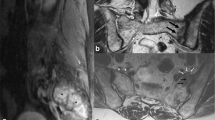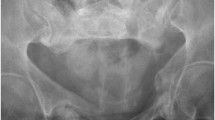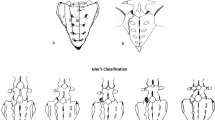Abstract
Introduction
Sacral insufficiency fractures are a well recognised cause for low back, buttock and groin pain in the elderly. However, over a 4 year period, four patients have presented with symptoms of cauda equina syndrome, who were found on investigation to have acute sacral insufficiency fracture without any other aetiological spinal abnormality.
Patients and method
Four patients who presented to the spinal surgeons of our institution with symptoms of cauda equina syndrome were referred for spinal MR. Sagittal and axial T1 and T2 weighted turbo spin echo sequences of the lower thoracic and lumbar spine were performed on all patients. Subsequent studies included MR of the sacrum supplemented where appropriate by CT and technetium MDP bone scintigraphy.
Results
No evidence of a compressive lesion of the lower thoracic or lumbar spine was present in any of the four patients. Dedicated MR examination of the sacrum in these patients revealed unilateral acute insufficiency fractures involving zone 1 from S1 to S3 extending from the sacro-iliac joint to the lateral margin of the sacral foramen. There was no evidence of compression of the sacral nerve roots. The possible mechanism for the symptomatic presentation is discussed.
Conclusion
Sacral insufficiency fractures should be excluded in elderly or osteoporotic patients presenting with cauda equina syndrome who have no evidence of compression in the thoraco-lumbar MR studies.



Similar content being viewed by others
References
Lourie H. Spontaneous osteoporotic fracture of the sacrum. An unrecognised syndrome of the elderly. JAMA 1982;248:715–7.
Ries T. Detection of osteoporotic sacral fractures with radionuclides. Radiology 1983;146:783–5.
Cooper KL, Beabout JW, Swee RG. Insufficiency fractures of the sacrum. Radiology 1985;156:15–20.
Peh WC, Khong PL, Ho WY, Yeung HW, Luk KD. Sacral insufficiency fractures. Spectrum of radiological features. Clin Imaging 1995;19:92–101.
Finiels PJ, Finiels H, Strubel D, Jacquot JM. Spontaneous osteoporotic fractures of the sacrum causing neurological damage. Report of three cases. J Neurosurg 2002;97 3 Suppl:380–5.
Vaccaro AR, Kim DH, Brodke DS, Harris M, Chapman J, Schildhauer T et al. Diagnosis and management of sacral spine fractures. J Bone Joint Surg [Am] 2004;86-A:166–75.
Denis F, Davis S, Comfort T. Sacral fractures: an important problem. Retrospective analysis of 236 cases. Clin Orthop Relat Res 1988;227:67–81.
Byrne TN. Disorders of the spinal cord and cauda equina. Curr Opin Neurol Neurosurg 1993;6:545–8.
Orendacova J, Cizkova D, Kafka J, Lukacova N, Marsala M, Sulla I et al. Cauda equina syndrome. Prog Neurobiol 2001;64:613–37.
Schmidek HH, Smith DA, Kristiansen TK. Sacral fractures. Neurosurgery 1984;15:735–46.
Bonin JG. Sacral fractures and injuries to the cauda equine. J Bone Joint Surg 1945;27-B:113–27.
Esses SI, Botsford DJ, Huler RJ, Rauschning W. Surgical anatomy of the sacrum. A guide for rational screw fixation. Spine 1991;16 6 Suppl:S283–8.
Jones JW. Insufficiency fracture of the sacrum with displacement and neurologic damage: a case report and review of the literature. J Am Geriatr Soc 1991;39:280–3.
Lock SH, Mitchell SC. Osteoporotic sacral fracture causing neurologic deficit. Br J Hosp Med 1993;49:210.
Aylwin A, Saifuddin A, Tucker S. L5 radiculopathy due to sacral stress fracture. Skeletal Radiol 2003;32:590–3.
Stabler A, Beck R, Bartl R, Schmidt D, Reiser M. Vacuum phenomena in insufficiency fractures of the sacrum. Skeletal Radiol 1995;24:31–5.
Murata Y, Takahashi K, Yamagata M, Takahashi Y, Shimada Y, Moriya H. Sensory innervation of the sacroiliac joint in rats. Spine 2000;25:2015–9.
Murata Y, Takahashi K, Yamagata M, Takahashi Y, Shimada Y, Moriya H. Origin and pathway of sensory nerve fibres to the ventral and dorsal sides of the sacroiliac joint in rats. J Orthop Res 2001;19:379–83.
Babayev M, Lachmann E, Nagler W. The controversy surrounding sacral insufficiency fractures: to ambulate or not to ambulate? Am J Phys Med Rehabil 2000;79:404–9.
Author information
Authors and Affiliations
Corresponding author
Rights and permissions
About this article
Cite this article
Muthukumar, T., Butt, S.H., Cassar-Pullicino, V.N. et al. Cauda equina syndrome presentation of sacral insufficiency fractures. Skeletal Radiol 36, 309–313 (2007). https://doi.org/10.1007/s00256-006-0239-5
Received:
Revised:
Accepted:
Published:
Issue Date:
DOI: https://doi.org/10.1007/s00256-006-0239-5




